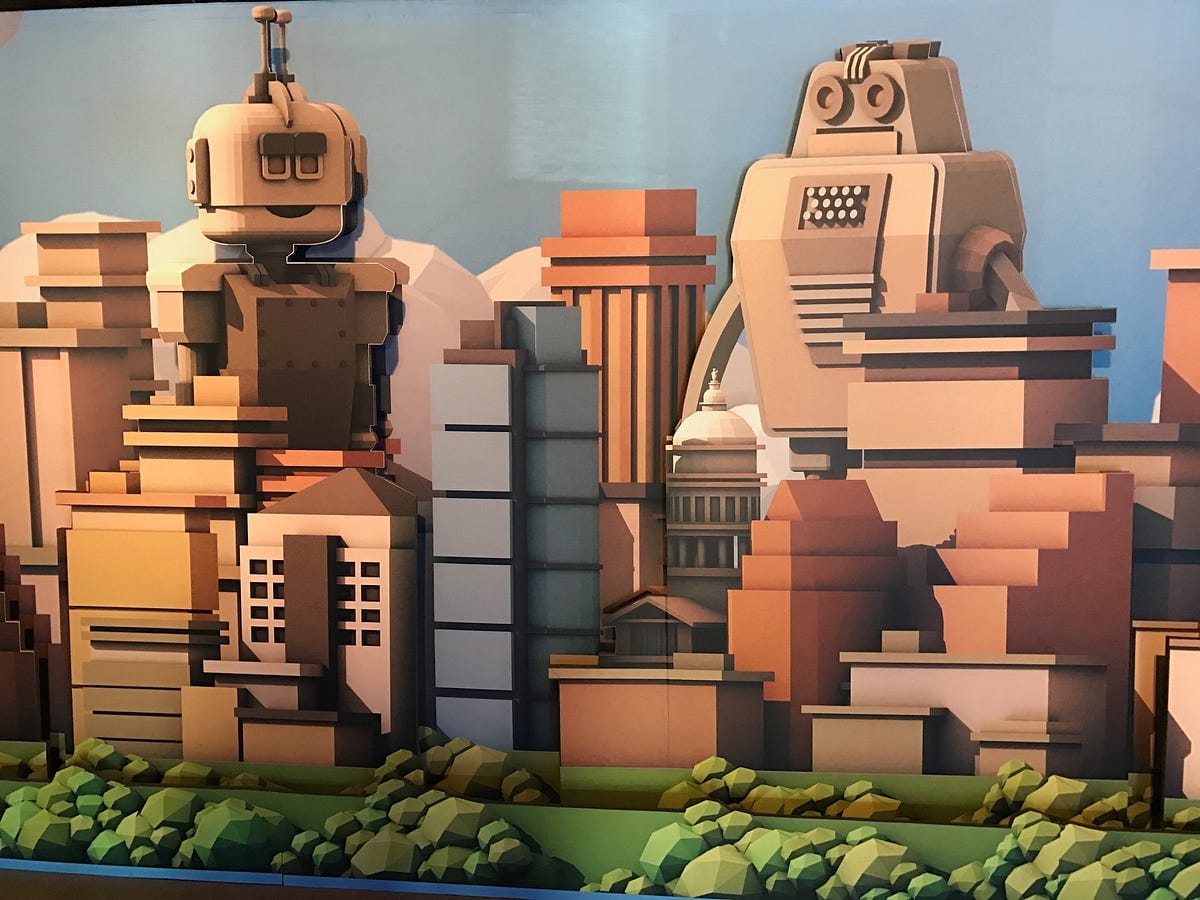Part 2: Talkabot conference liveblog

I spent last week in Austin, Texas attending the first Talkabot Conference. Yesterday was the tutorial day, today is all about the first day of talks.
Ben Brown, Howdy/BotKit/Talkabot
Ben opened the conference with the history of his thinking on bots, and how the conference planning took over a year, and gave us a preview of the day ahead.
Facebook Messenger
Mikial the tech lead on Messenger started with stats: 1 billion users on Messenger, 34,000 developers making over 33,000 bots on Messenger. They just introduced payments, web views, sharing, and ads for bots. Current roadmap is looking at user experience, analytics/tracking, reach, and scalability. Rich UI allows photos, video, buying, etc in messages for flexible uses. Messenger payments powered by Stripe and PayPal for now, more to come. You have to request early access to payments by at this page. Sharing inside the app will let you share bots to others. They have a new classification of apps they call “aggregators” which are one app for a lot of bots/pages. Showed a demo of Shopify, where their Facebook business page can offer up a bot to users in Messenger automatically to anyone that liked their page and even lets people order something on their service.

Poncho
There are nearly a billion users (each) on three major chat app systems, which they see as their potential market. They’re trying to make weather fun, so they hired comedy writers to help write updates. Eventually it may talk about traffic and public transit outages for you in the morning before work. Poncho’s iOS app is an alarm clock based on current weather. Poncho will send a message on fb Messenger when it’s about to rain where you are. They wanted to review their bot, so they built a live real-time feed that lets them watch how users interact with the service, so they could make it smarter. They built a large CMS controlling triggers and messages so writers can easily write new posts. They also built their own bot analytics. Did tons of analytics works to refine the app and maintain retention.
Roadmap: hoping to launch on Kik, Alexa, and Allo next. Content: going from weather, to horoscopes, to eventually things like daily comics. They also launched a blog of good bot interactions: http://whatthebot.ai/

Erika Hall, Design with Words
Erika rocked the house with a talk about bot design coming from her two decades of work on good content and UI.
“Bots are words as design, words as apps, and we’re used to talking to one another so we should be flocking to these possibilities. Yet, the walls between coding, design, and content in most companies end up making apps worse, since content is often brought in late in the process, and they don’t get to monitor usage to improve after launch. Conversation is the new interface. Over 150,000 years we moved from an oral culture to a literary culture. Things that were public became private. Immediacy and context are terrific, being in the here and now. Words first! The ideal interface is no interface.”
She shared goals for bots: They should give just enough info, be truthful, be relevant, be brief and orderly, and unambiguous.
“Don’t make people think. Language is a social phenomena, just as apps are a social phenomena now too, design interactions by having conversations, real interactions. Prototype your bot by talking over a table with another person — every bot conversation should be designed like this at the start instead of as written documentation and written comps. It does have to be documented, but that shouldn’t be the start of any project. How to write good dialogue: “You have to like people”. Research: study your subject, listen without judgment, expose yourself to good language, watch users.”
Christian Brucculeri, CEO Snaps.com
Shared what he learned building branded bots for major corporations. Messaging apps, emoji keyboards, and bots for the biggest brands. It was great to hear from someone already making a living from the field, albeit through client work producing free apps instead of paid bots.
“Brands are generally risk adverse, they don’t want to end up in the news after their bots say something terrible.” Showed several examples but one rose above the rest. Jordan’s Training Breakfast Club looked like a set of well-designed notifications to get your daily morning workouts ready. They ping you in the morning, then ask you how it went hours after, and they iterated for months to get the interactions right. The audience was elite high school athletes and they loved it. Didn’t require an app, just SMS.
Marriott hotels also uses their work for their rewards program and planning travel, all interactions you have have with a bot. They sort of pioneered sticker-type apps when they launched Kimoji last year.
Kip and the Visual Language of Bots
The team behind Kip described their service and shared lessons from working with over one million transactions on their platform. Currently they connect their bot with Amazon and other online outlets to help you purchase supplies for an office, planning to expand to things like ordering food through Grubhub soon. Kip Cafe is their consensus engine. They wrote their own markup language to translate work across platforms (Slack, fb Messenger, Kik, Telegram). Their conversable forms, using Slack message buttons uses edit controls to minimize the number of messages. They also mentioned that Jeff Pulver is starting an industry association for chatbot developers.
Esther Crawford, Why You Need a Personal Bot
Wrote a bot about herself when looking for a job, and loaded it with personal stories, about how she grew up in a cult religion and studied Arabic in college. “Everyone is into social, but profiles are static, and instead soon everyone should have a personal (conversational profile) bot.” The goal of her bot was to appear to be a real human telling you their life story through chat.
Olabot is her product that lets you build your own Facebook Messenger bot about yourself. Their goals are to give everyone a bot, make them conversational, work on every platform, and be easy to train. “Continuous onboarding” is the process where they quiz you constantly about your life and your answers get built into the bot. Bots are a natural evolution of the personal profile, capture stories, interests, and voice. Chris Messina’s bot is an early test case.

Drew Magliozzi of AdmitHub, conversational AI for college success
Drew builds bots for students to get through college, primarily SMS.
The problem: 14% of students don’t show up on the first day of class and never end up attending even after being accepted. 42% of students drop out before graduating. His company uses text messaging to converse with college students, with the goal of lowering both those statistics by offering help and counseling during the semester. Their case study was at Georgia State.
At Georgia State, 22% weren’t showing up the first day of class. After their bot was deployed it had a 64% high engagement, with 88% responding to it at least once. When students asked hard questions, they’d forward them to university staff to answer, but Drew had to build an email-as-interface for university staff, who didn’t want to use native chat clients. He ended up building an entire triage CMS (that looks like Slack) to handle questions from students and escalate them to the proper person to answer, etc.
The results were positive in every aspect they measured. They’re using machine learning so it gets continuously better at its job year after year with new classes. They admit onboarding could have been better and better explained the service to students (some of whom ignored it, not knowing what it was). 75% students had smartphones but going SMS meant they could reach the poorest, most vulnerable students.

Tom Hadfield message.io, Building Multi-platform Bots
Tom’s goal was bots that work everywhere. “Today it’s like making web pages only for IE. Every platform has their own API and methods, there’s no W3C of standards or any markup language, so there’s little interoperability. Slack dominates the bot market in enterprise, near 100%.”
So he built a translation service, to help developers port apps to other platforms. It’s a meta-API that developers send all traffic to their service, which then relays all the other platform APIs. Bots can be cross-platform, and work in both enterprise and consumer chat apps. They try and match UI elements across platforms. The goal is write once, run on all bots everywhere, with cross-platform code being as good as natively written code.

Conversation with Ted Livingston, CEO Kik
“Chat is the new web, bots are the new browsers”
More new bots launch on WeChat each day than new sites launch on the web. Kik is getting in-app payments soon and will be a revolution. 99% sure commerce will be huge in bots, like the mobile app revolution of several years ago.Bots will get rich media soon.
Hipmunk CEO — “Hipmunk bot is better than the mobile website, maybe even better than hipmunk’s own mobile app.”
Barbara Ondrisek, hipster cat bot
She wanted a hipster bot to tell everyone where they should go to hang out, so she built one. It tells you about new restaurants and popular bars. At first she had trouble launching on platforms, often getting denied thinking it was a joke project, but eventually hipster cat bot got featured front and center on most bot stores. Runs a chatbot agency now in Austria.
Lauren Golembiewski, antisocial software
“Ghost for Burner” is a bot to help women get rid of jerks, as it takes over your account and texts them for you. It started from a Burner hackathon. It’s a bot that ghosts people. Uses natural language understanding, was trained by a Hollywood screenwriter. Bots can improve our lives. It’s a bot for a broken dating culture. Voxable is her company.
Sam Williams, Delivering the News with Bots
Sam talked about the Quartz app. They really wanted to focus the app on iOS notifications. There was an option of making it a blank screen app that only operated as notifications and they explored that before going with their messaging interface. Showed mockups of early design sketches, all notifications and cards. Their first bot version wasn’t as entertaining as it could be, as it imported news alerts clearly written for their website. So they had to rewrite content for the platform to make it work.
They looked for existing CMSes. They basically needed to build a “choose your own adventure” content system, but for News. They started with Twine to manage news conversations and built out their own CMS to let writers edit copy without having to touch code. Quartz has rules: they never show users the same thing twice, always show users new stuff over older stuff. They wrote a custom mobile UI into their desktop CMS to better preview how messages would look on phones. Lessons learned: shorter is better, not too much scrolling, liberal use of emoji/GIFs, and live events are challenging, since their news evolves and they have to handle updates gracefully.
It was fascinating to hear that Quartz employs six people rewriting every line of news copy that comes from their parent service, with 4 daily updates of about 3 items every day.
Overall, the first day of Talkabot covered a broad range of topics. From major platforms like Facebook Messenger and Kik talking about their future roadmaps, to people making commercial bots like Kip and Snaps.com, to smaller projects like Hipster Cat Bot and Ghost for Burner.
Hearing the stories of Admit Hub and how their bot improved the lives of students new to college was inspiring. Erika Hall’s talk on bot design was a fantastic look at the history of human interaction and pointed out what we’re obviously missing when we build bots today. It was great to hear Poncho and Quartz went the extra mile and hired writers to redo their content for the best possible bot/app experience.
Continue reading: the second day of Talkabot conference sessions
Subscribe to our newsletter.
Be the first to know - subscribe today



